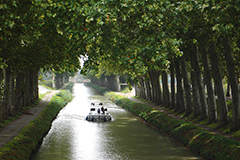Canal du Midi
The Canal du Midi is a 240 km (150 mi) long canal in Southern France. Originally named the Canal royal en Languedoc (Royal Canal in Languedoc) and renamed by French revolutionaries to Canal du Midi in 1789, the canal was at the time considered one of the greatest construction works of the 17th century.
 The canal connects the Garonne to the Étang de Thau on the Mediterranean and along with the 193 km (120 mi) long Canal de Garonne forms the Canal des Deux Mers, joining the Atlantic to the Mediterranean. The canal runs from the city of Toulouse down to the Étang de Thau near the Mediterranean.
The canal connects the Garonne to the Étang de Thau on the Mediterranean and along with the 193 km (120 mi) long Canal de Garonne forms the Canal des Deux Mers, joining the Atlantic to the Mediterranean. The canal runs from the city of Toulouse down to the Étang de Thau near the Mediterranean.
Strictly speaking, "Canal du Midi" refers to the portion initially constructed from Toulouse to the Mediterranean – the Deux-Mers canal project aimed to link together several sections of navigable waterways to join the Mediterranean and the Atlantic: first the Canal du Midi, then the Garonne which was more or less navigable between Toulouse and Bordeaux, then the Garonne Lateral Canal built later, and finally the Gironde estuary after Bordeaux.
Jean-Baptiste Colbert authorized the start of work by royal edict in October, 1666, with the aim of developing the wheat trade, under the supervision of Pierre-Paul Riquet, and construction lasted from 1666 to 1681, during the reign of Louis XIV. The Canal du Midi is one of the oldest canals of Europe still in operation (the prototype being the Briare Canal). The challenges in these works are closely related to the challenges of inland water transport today. The key challenge, raised by Pierre-Paul Riquet, was to convey water from the Montagne Noire (Black Mountains) to the Seuil de Naurouze, the highest point of the canal.
The Canal du Midi was inscribed as a UNESCO World Heritage Site in 1996. More details
 The canal connects the Garonne to the Étang de Thau on the Mediterranean and along with the 193 km (120 mi) long Canal de Garonne forms the Canal des Deux Mers, joining the Atlantic to the Mediterranean. The canal runs from the city of Toulouse down to the Étang de Thau near the Mediterranean.
The canal connects the Garonne to the Étang de Thau on the Mediterranean and along with the 193 km (120 mi) long Canal de Garonne forms the Canal des Deux Mers, joining the Atlantic to the Mediterranean. The canal runs from the city of Toulouse down to the Étang de Thau near the Mediterranean.Strictly speaking, "Canal du Midi" refers to the portion initially constructed from Toulouse to the Mediterranean – the Deux-Mers canal project aimed to link together several sections of navigable waterways to join the Mediterranean and the Atlantic: first the Canal du Midi, then the Garonne which was more or less navigable between Toulouse and Bordeaux, then the Garonne Lateral Canal built later, and finally the Gironde estuary after Bordeaux.
Jean-Baptiste Colbert authorized the start of work by royal edict in October, 1666, with the aim of developing the wheat trade, under the supervision of Pierre-Paul Riquet, and construction lasted from 1666 to 1681, during the reign of Louis XIV. The Canal du Midi is one of the oldest canals of Europe still in operation (the prototype being the Briare Canal). The challenges in these works are closely related to the challenges of inland water transport today. The key challenge, raised by Pierre-Paul Riquet, was to convey water from the Montagne Noire (Black Mountains) to the Seuil de Naurouze, the highest point of the canal.
The Canal du Midi was inscribed as a UNESCO World Heritage Site in 1996. More details
